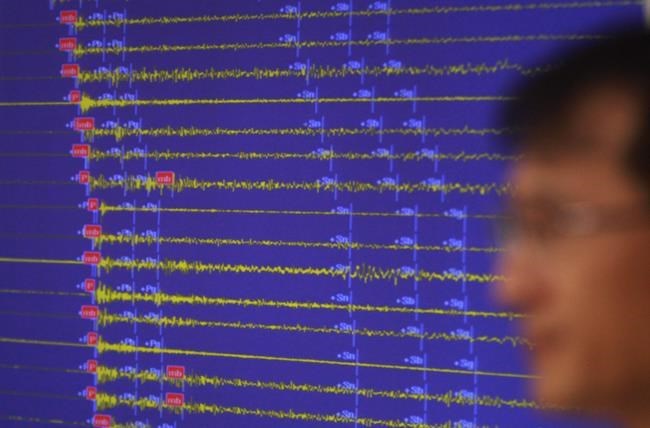EDMONTON — The Alberta Energy Regulator has cited an energy company for causing a series of earthquakes, including the largest recorded tremblor in the province's history.
The environmental protection order issued against Obsidian Energy Ltd. Thursday came the same day a scientific paper was published showing those earthquakes were caused by industry activity -- not natural causes, as the regulator initially suggested.
In November, parts of Alberta near the northwestern town of Peace River were rocked by a series of quakes culminating in one that reached a 5.6 magnitude.
Residents reported being knocked to their knees. The earth was pushed upward by more than three centimetres — enough to register on satellites.
"This event was caused by wastewater disposal," said Ryan Schultz, a Canadian seismologist who helped conduct the research while at Stanford University in California. His paper on the event, written with colleagues at the University of Alberta and Natural Resources Canada, was published Thursday morning in the journal Geophysical Research Letters.
In a release Thursday evening on Twitter, the energy regulator said the protection order was issued after its own investigation.
"An investigation conducted by the Alberta Geological Society, a branch of the AER, has concluded that Obsidian’s disposal operation induced the seismic events," it said.
Oilpatch techniques, such as deep disposal wells that inject wastewater kilometres underground, can induce earthquakes. One such well located near the earthquake site, used to dispose of water used in oilsands operations, has injected more thanone millioncubic metres of wastewater down about two kilometres.
After the record-breaking quake occurred, the Alberta Geological Society attributed it to natural causes. The centre of the quake, then estimated to be six kilometres underground, was thought too deep and too far away from oilpatch activity in time and space to have been generated by industry.
Not so, said Schultz.
A closer and more thorough look at the data brought the centre of the quake up to about four kilometres beneath the surface. At some point, the regulator's catalogue of Alberta quakes was changed to reflect that figure.
Similarly, Schultz said a look at previous research on so-called "induced seismicity" revealed long lag times between deep-well water injection and earthquakes.
A previous disposal site in Alberta started quaking three years after pumping began, Schultz said. A Dutch disposal well didn't start causing earthquakes for decades.
As well, history shows deep water disposal can cause earthquakes up to 20 kilometres away. Alberta's November earthquakes were nowhere near that distant.
"The clusters of earthquakes were right on top of a deep disposal well," Schultz said.
His paper suggests that the injected water forced itself between the two sides of a fault deep in the earth. That water was enough to reduce the friction holding the two sides together and eventually resulted in a slippage that shook the surface.
Statistical analysis of the correlation between the quakes and the underground pumping was conclusive, Schultz said.
"We had a confidence somewhere between 89 and 97 per cent just in the timing," he said. "There is enough information to start making these kinds of links."
Schultz said the findings could have big implications for Canada's and Alberta's climate change plans.
Both jurisdictions favour reducing the climate impact of the province's energy industry by pumping vast amounts of waste carbon dioxide deep underground, much as wastewater is injected. So-called carbon capture and storage could have the same seismic effects as deep wastewater disposal, Schultz said.
"If carbon capture is going to be done at a scale that is going to combat climate change, then significant amounts of volume need to be put in the ground," he said. "You might expect then also getting these types of earthquakes the more volume that you store."
That doesn't necessarily mean carbon capture and storage is a bad idea, he said, but it means a lot more seismic monitoring needs to take place around the sites to keep track of what's happening deep in the earth.
"This could be an issue," Schultz said. "Monitoring will tell.
"You need to be able to see what is going on."
Obsidian now must submit plans and take actions to reduce the frequency and magnitude of the events, says the protection order, which covers the November quake as well as subsequent events on March 16.
The company, an oil and gas producer that pumps about 33,000 barrels of oil equivalent a day, must also establish seismic monitoring in the surrounding area and install equipment within a 10-kilometre radius of the disposal operation to measure vibration.
This report by The Canadian Press was first published March 23, 2023.
— Follow Bob Weber on Twitter at @row1960.
Bob Weber, The Canadian Press




